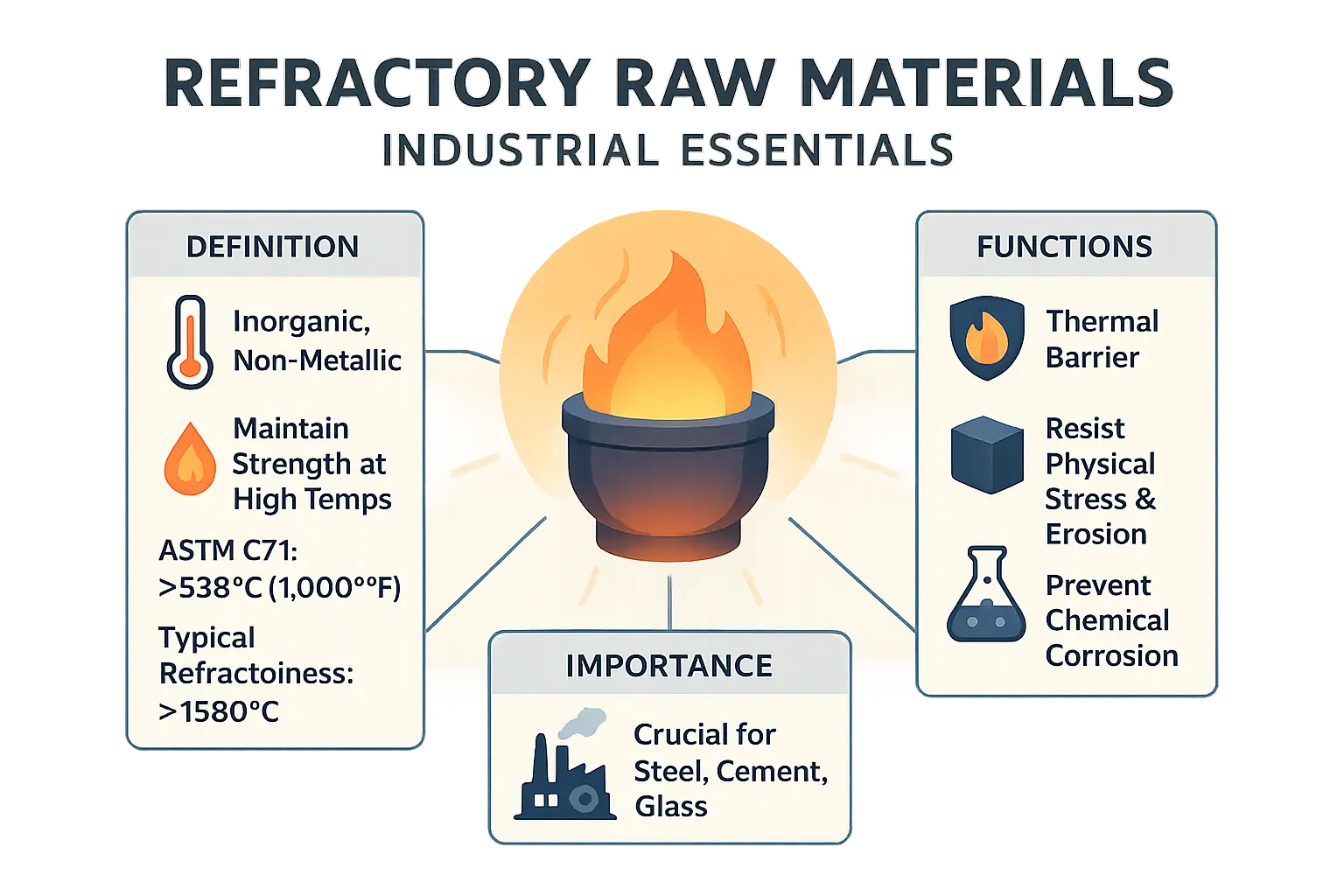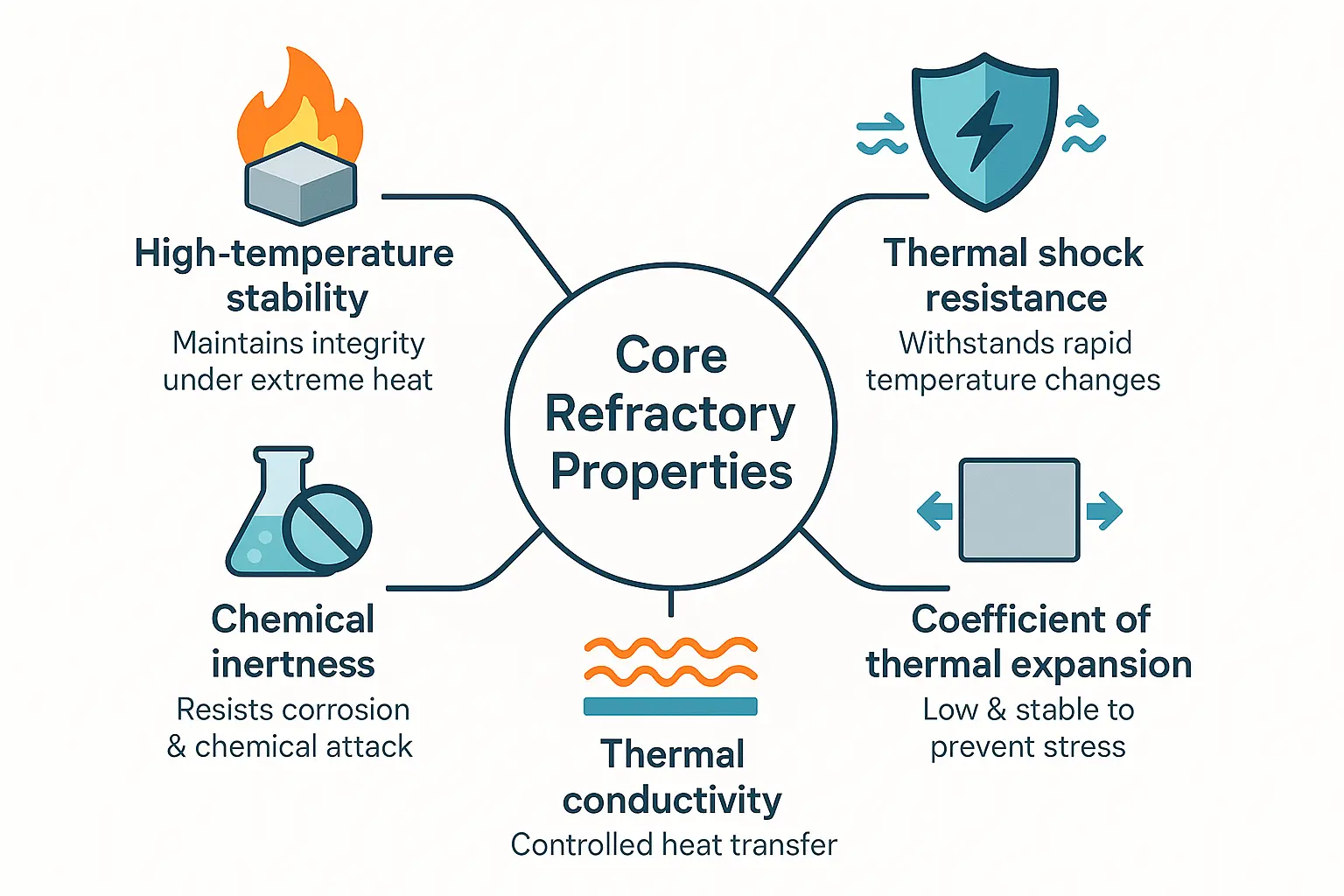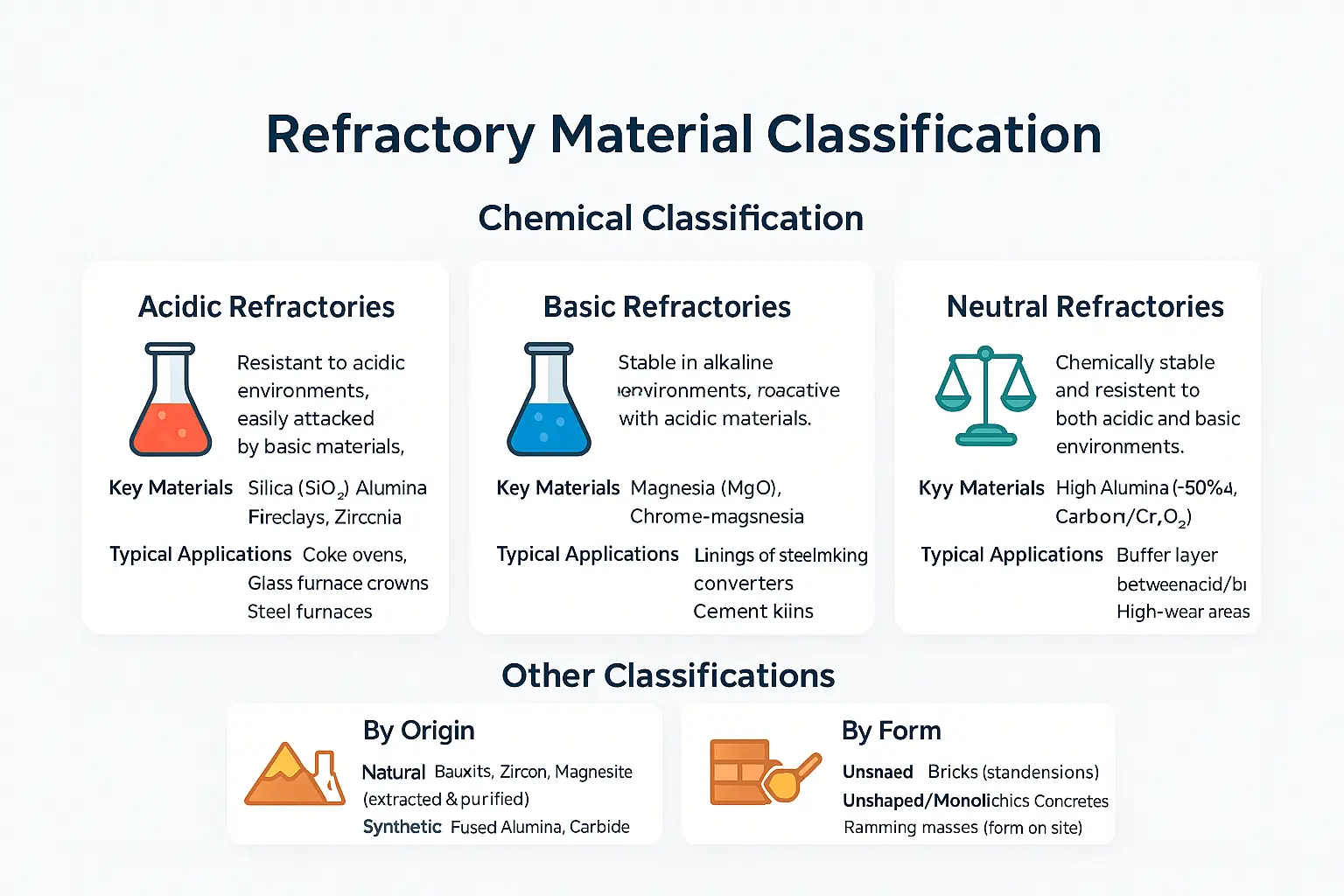Ever wondered how industries survive the inferno of extreme heat without melting down? Refractory raw materials hold the secret, forming the unsung backbone of high-temperature resilience. These inorganic, non-metallic substances—like alumina, silica, and magnesia—defy decomposition at temperatures exceeding 1,580°C, shielding everything from steelmaking furnaces to glass kilns. This article decodes their science, revealing how their unique blend of thermal stability, chemical inertness, and mechanical durability creates armor against industrial chaos. Dive into their classification, from acidic to neutral compositions, and uncover why choosing the right refractory raw materials isn’t just engineering—it’s the difference between operational triumph and catastrophic failure.
- What Are Refractory Raw Materials and Why Are They Essential?
- The core properties that define refractory performance
- A systematic classification of refractory raw materials
- An overview of key refractory raw materials
- From Raw Earth to High-Performance Component: The Transformation Process
- Industrial Applications: Where Resistance Is Paramount
- Sustainability and the Lifecycle of Refractory Raw Materials
- Choosing the right foundation for ultimate performance
What Are Refractory Raw Materials and Why Are They Essential?
Defining the Foundation of Industrial Resistance
Refractory raw materials are inorganic, non-metallic substances engineered to withstand extreme thermal, chemical, and mechanical stress. Defined by ASTM C71, these materials must endure temperatures exceeding 538°C (1,000°F) while maintaining structural integrity. Their refractoriness typically surpasses 1,580°C, with compositions ranging from porous to dense, crystalline to amorphous. Key components include oxides like alumina (Al₂O₃), silica (SiO₂), and magnesia (MgO), alongside carbides and nitrides of silicon, zirconium, and boron. Notably, zirconia (ZrO₂) is critical for glass furnaces due to its low thermal conductivity, while silicon carbide (SiC) excels in conductive applications. These materials are categorized chemically: acidic (e.g., silica), basic (e.g., magnesia), and neutral (e.g., carbon graphite), each tailored to specific industrial environments.
The Critical Role in High-Temperature Processes
These materials act as thermal barriers, shielding equipment from temperatures exceeding 1,700°C in metallurgy and glassmaking. They resist physical stress from abrasion, mechanical wear, and thermal shock while blocking corrosive chemical reactions from molten metals, slags, and gases. Without them, industries like steel, cement, and glass production would face catastrophic equipment failures. For instance, a steelmaking furnace’s lining—crafted from these essential substances—ensures molten steel doesn’t compromise structural integrity. Beyond protection, they optimize energy efficiency, reducing fuel costs by up to 7% when properly applied, and enable advanced processes in hydrogen reformers, sulfur furnaces, and even flame-deflecting structures in rocket launch pads. Their economic impact is vast: the U.S. market alone reached $3.02 billion in 2022, driven by demand in steelmaking, petrochemicals, and aerospace—sectors where material failure could halt production and incur losses exceeding $1 million per day in unplanned shutdowns.

The core properties that define refractory performance
A unique combination of characteristics
Refractory materials combine extreme thermal, chemical, and mechanical resistance to ensure reliability in high-temperature environments like steel converters and glass furnaces. These properties work synergistically to protect infrastructure in metallurgy, cement production, and petrochemical processing where temperatures exceed 1600°C.
- High-temperature stability: Maintains structural integrity beyond 1580°C, with super refractories like tantalum hafnium carbide (4215°C melting point) enduring extreme conditions in steelmaking and aerospace flame deflectors. This property prevents deformation under prolonged exposure to molten metals.
- Thermal shock resistance: Survives rapid 1000°C+ temperature swings in steel ladle cycles. MgO-C bricks maintain integrity during VOD refining, where sudden cooling from molten steel contact would crack inferior materials, risking production downtime and safety hazards.
- Chemical inertness: Resists corrosion from molten metals (≥1600°C) and aggressive slags via Al2O3-SiO2-C compositions. This prevents alkali vapors in ceramic kilns from forming structure-degrading compounds like potassium feldspar, which causes spalling in less resistant materials.
- Thermal conductivity: Engineered for specific needs—low (0.35 W/m°C zirconia) for insulation or high (35 W/m°C graphite) for heat transfer to optimize energy efficiency in cement kilns, where improper conductivity increases fuel consumption by 15-20%.
- Coefficient of thermal expansion: Silicon carbide (4-5×10⁻⁶/K) minimizes stress cracks during thermal cycling in ceramic kilns by maintaining dimensional consistency. A mismatched coefficient would cause spalling from expansion rate differences between layers.
These properties drive performance in critical applications. MgO-CaO refractories (25-60% porosity) balance thermal resistance with chemical stability in secondary steelmaking, where porosity must prevent alkali penetration without reducing mechanical strength. Fireclay bricks (10-20 MPa compressive strength) withstand mechanical stress in aluminum smelting, resisting erosion from molten metal flow. Innovations like Drytech® technology reduce CO2 emissions by 50% during production through cement-free colloidal silica bonding, eliminating explosive vaporization risks during furnace startup.

A systematic classification of refractory raw materials

Classification by chemical nature
Refractory materials are categorized by chemical composition to ensure compatibility with industrial environments. The three classes—acidic, basic, and neutral—dictate resistance to chemical aggression and thermal stress, crucial for steel, glass, and cement applications. Mismatched materials risk rapid degradation, leading to costly process failures.
| Chemical Classification | Description | Key Raw Materials Examples | Typical Applications |
|---|---|---|---|
| Acidic | Resistant to acidic environments but vulnerable to basic materials. Silica-based options excel in thermal shock resistance. | Silica (SiO₂), Alumina (Al₂O₃), Fireclays, Zirconia (ZrO₂) | Coke ovens, glass furnace crowns. Silica bricks, for example, are cost-effective in steelmaking due to high load-bearing capacity. |
| Basic | Stable in alkaline conditions but reactive with acidic materials. Magnesia-based refractories resist slag corrosion. | Magnesia (MgO), Dolomite, Chrome-magnesia | Liners in steelmaking converters and cement kilns. Magnesia-chrome combinations withstand iron-rich slags in oxygen converters. |
| Neutral | Stable in acidic and basic environments. Carbon-based materials require inert atmospheres to prevent oxidation. | High Alumina (>50% Al₂O₃), Chromia (Cr₂O₃), Carbon/Graphite | Buffer layers between acid and basic refractories. Chromia bricks resist alkali vapors in cement kilns. |
Classification by origin and manufacturing
Material origin and form dictate performance. Natural materials like bauxite (alumina), zircon (zirconia), and magnesite (magnesia) are extracted and refined, while synthetic options like fused alumina are engineered for enhanced properties. Shaped products (bricks) contrast with unshaped monolithics (castables), which adapt to on-site needs. Silicon carbide, for instance, suits high-temperature applications due to superior thermal conductivity.
For deeper insights into oxide-based materials like those mentioned in These oxide-based materials, explore their role in resisting extreme conditions. This dual classification—chemical and physical—ensures optimal material selection for industrial demands. Neutral refractories like high-alumina bricks bridge acidic and basic environments, while unshaped monolithics reduce joint-related weaknesses in cement kilns, improving efficiency.
An overview of key refractory raw materials
Refractory raw materials enable industrial systems to withstand extreme conditions like temperatures exceeding 1,580°C, chemical exposure, and mechanical stress. These materials are critical for industries such as steelmaking, glass production, and cement manufacturing, where operational failures would lead to catastrophic downtime and safety risks. Their selection depends on balancing thermal stability, corrosion resistance, and structural integrity. Here’s a breakdown of critical materials driving this sector.
Alumina-based materials
Alumina (Al₂O₃) is a cornerstone of refractory technology, prized for its thermal and chemical resistance. Its versatility spans applications from metallurgical furnaces to advanced ceramics:
- Bauxite: The primary natural source for alumina extraction, refined to >85% purity for high-temperature applications like metallurgical furnaces. Bauxite-derived materials resist acidic slags and maintain structural integrity up to 1700°C.
- Calcined and Fused Alumina: Synthetic variants exceeding 98% purity offer extreme durability. High alumina refractories dominate steelmaking, resisting thermal shock and corrosive slags while retaining strength above 1100°C. These materials are engineered for low thermal expansion, making them ideal for ladle linings and kiln furniture in cement plants.
Silica and magnesia-based materials
This category balances cost-efficiency with specialized performance:
- Silica (SiO₂): Sourced from quartzite, it excels in load-bearing applications at elevated temperatures. Silica bricks with >93% SiO₂ provide structural stability at 1600°C, though they’re vulnerable to alkali attacks. These bricks are critical for coke oven walls, where they withstand mechanical stress under high thermal gradients.
- Magnesia (MgO): Extracted from magnesite, it forms basic refractories critical for steelmaking furnaces. Blends with carbon enhance lining durability by combining chemical stability with thermal conductivity. Magnesia-chromite composites, for instance, resist basic slags in cement kilns, extending service life beyond 10,000 cycles.
Other critical raw materials
Emerging materials address specialized needs:
- Zirconia (ZrO₂): Derived from zircon, it resists corrosion and molten glass at extreme temperatures. Fused zirconia maintains dimensional stability in glass manufacturing, reducing energy losses in furnace walls. Its low thermal conductivity and high erosion resistance make it ideal for submerged combustion nozzles in glass tanks.
- Chromite (Cr₂O₃): Blended with magnesia, it creates composites with enhanced thermal shock resistance for cement kilns, preventing spalling during rapid temperature changes. These composites retain mechanical strength at 1800°C, outperforming magnesia-carbon alternatives in oxygen-rich environments.
- Carbon and Graphite: Thrive in reducing atmospheres, offering non-wetting properties for molten metal containment in aluminum and copper production. Graphite crucibles resist erosion from non-ferrous metals due to their layered atomic structure, though oxidation limits use above 800°C in air.
- Fireclays: Cost-effective materials with 25-45% alumina, suitable for moderate-temperature applications up to 1580°C where thermal cycling is minimal. Fireclay bricks (ASTM C71 classified as “fireclay refractories”) are used in boiler linings and glass tank furnaces, though impurities like iron oxide reduce performance in highly corrosive environments.
From Raw Earth to High-Performance Component: The Transformation Process
Refractory raw materials undergo precise industrial processing to become robust components for extreme environments. As a global leader in refractory solutions, MXS Refractories employs advanced techniques to transform these materials into products capable of withstanding temperatures exceeding 1,500°C while resisting chemical and mechanical stress. This process ensures materials meet the exacting demands of industries like glass and steel manufacturing, where failure risks could disrupt production or compromise safety.
Thermal Processing: Unlocking Material Potential
Thermal treatments are critical for enhancing material stability. These steps refine structural integrity and durability, enhancing structural integrity:
- Calcination: Raw minerals like magnesite are heated to 1,650–1,850°C to remove chemically bound water and carbonates, producing stable magnesia. This step prevents post-processing defects like cracking.
- Sintering: Particles are heated below their melting point to fuse into dense, cohesive masses. This improves resistance to thermal shock and mechanical wear, creating a durable microstructure.
- Fusion: For fused cast refractories, materials are melted at extreme temperatures (e.g., 1,350–1,550°C for alumina) and cast into molds. Controlled cooling creates ultra-pure, high-density components with minimal porosity, ideal for glass furnace linings.
Mechanical and Chemical Preparation
Physical and chemical refinement ensures impurity-free raw materials. Key steps include:
- Beneficiation and Flotation: Impurities like silicate gangue are removed through flotation techniques. For example, scheelite ores use reagents (e.g., Na₂CO₃, SS, SG) to recover 79.4% of tungsten oxide efficiently, reducing carbon emissions by over 5,000 tons annually.
- Crushing and Grinding: Materials are reduced to controlled particle sizes (e.g., -0.074 mm for scheelite) to optimize packing density. Uniform granulometry ensures product uniformity.
- Magnetic Separation: Iron-based contaminants are extracted using magnetic fields. Trace iron lowers melting points, making this step essential for high-purity applications.
These processes guarantee materials meet MXS Refractories’ standards for performance in challenging environments. By leveraging innovations like AI-driven flotation control and eco-friendly reagents, MXS ensures operational efficiency and sustainability in every refractory solution.
Industrial Applications: Where Resistance Is Paramount
Refractory raw materials serve as the first line of defense in environments where extreme conditions threaten equipment integrity. Over 70% of all refractories are consumed in the steel industry alone, but their role extends to sectors where chemical aggression, mechanical stress, and temperatures exceeding 1,500°C demand unwavering performance. These materials aren’t just passive barriers—they’re engineered solutions that enable industrial processes to operate without catastrophic failure. Without them, production halts, costs surge, and safety risks escalate.
Core Industries and Their Refractory Needs
Each industry’s demands shape the choice of refractory materials, ensuring survival in hostile environments:
- Steel Industry: The largest consumer, relying on refractories to withstand temperatures above 1,600°C in blast furnaces, converters, and ladles. Magnesia-carbon bricks resist slag corrosion, while alumina-silica components endure thermal shock in reheating furnaces. Failure here risks molten metal leaks—a single incident could cost millions in downtime.
- Cement Industry: Rotary kilns operate at 1,400–1,500°C with alkali-rich clinker. Alumina-rich castables in calciners prevent alkali penetration, while silicon carbide bricks in burning zones resist abrasion. Poor material selection accelerates wear, increasing maintenance frequency by 40% or more.
- Glass Industry: Fused zirconia (ZrO₂) dominates in glass tanks, where temperatures hit 1,600°C. Its low glass compatibility prevents contamination, but even these materials erode over time—replacements every 5–10 years are standard. AZS (Al₂O₃-ZrO₂-SiO₂) bricks balance corrosion resistance with thermal shock tolerance in critical zones.
- Petrochemical Industry: In fluid catalytic cracking units (FCCUs), chromia-based castables endure 1,000°C+ in regenerators. High-alumina shapes in hydrocrackers resist hydrogen embrittlement. Without these materials, reactor linings degrade, risking unplanned shutdowns that cost $50,000–$200,000 per day in lost production.
Sustainability and the Lifecycle of Refractory Raw Materials
Addressing the Environmental Footprint
Refractory raw materials, essential for withstanding extreme industrial conditions, come with environmental challenges. Their extraction and processing demand significant energy, particularly during calcination and fusion stages. For example, materials like alumina (Al₂O₃) and magnesia (MgO) require temperatures exceeding 1,580°C, contributing to high CO₂ emissions. Mining activities also disrupt ecosystems, releasing pollutants into air and water. Silica (SiO₂) extraction, for instance, generates dust and chemical runoff, affecting local biodiversity. These impacts underscore the need for sustainable practices in an industry critical to steel, glass, and cement production.
The Move Towards a Circular Economy
To mitigate these impacts, the refractory industry is adopting circular strategies. Recycling used refractories has gained traction as virgin material shortages and costs rise. Over 70% of steel industry refractories are now reclaimed, with projects like LIFE 5RefrACT repurposing steel plant residues for furnace linings. Orbix’s innovations further demonstrate this shift: recovering metals from industrial waste streams and converting them into high-quality products like Stinox® for construction. Such efforts not only reduce landfill waste but also cut reliance on primary resources, aligning with the “4R” circular principles (Reduce, Reuse, Recycle, Repurpose).
Advancements in manufacturing also play a role. Drytech® technology slashes CO₂ emissions by 50% during refractory drying, thanks to its low-liquid, high-permeability design. Similarly, robotic dismantling of refractory installations minimizes dust and improves material recovery rates. These innovations extend the complete lifecycle of refractory materials, ensuring they perform efficiently while reducing environmental strain. By prioritizing durability—such as through pre-oxidation treatments that delay carburation in alloys—companies like MXS Refractories help industries lower replacement frequency, merging economic and ecological benefits.
Choosing the right foundation for ultimate performance
Refractory raw materials form the backbone of industrial resilience. Alumina, magnesia, and zirconia endure extreme temperatures (≥1580°C), chemical aggression, and mechanical stress, enabling critical processes in steel, glass, and cement industries. Their ability to resist corrosive slags and thermal shocks ensures operational continuity where failure is unacceptable.
Selecting the right refractory solution demands precision. Factors like thermal cycling, slag viscosity, and installation practices determine lifespan. For example, improper drying protocols can cause spalling, while minor deviations in water content during installation reduce cold crushing strength by 20% or more. These challenges underscore the hidden costs of oversight: unplanned downtime, increased maintenance, and compromised product quality.
Independent expertise is essential. Custom refractory engineering aligns chemical compositions, thermal thresholds, and mechanical properties with operational demands. At MXS Refractories, we combine field data with analytics to deliver solutions that outlast conventional alternatives by 40%. Precision in material sourcing and on-site supervision directly extends equipment life and reduces total cost of ownership.
Industries facing extreme conditions need tailored solutions. Whether optimizing pore structure for slag resistance or integrating carbon-bonded systems for vacuum environments, custom refractory engineering transforms vulnerabilities into strengths. The future of industrial durability hinges not on raw materials alone—but on the expertise that refines them.
Refractory raw materials ensure industrial resilience, delivering thermal stability, chemical resistance, and structural integrity. Alumina, zirconia, and magnesia enable efficiency in steel, cement, and glass sectors. Sustainability drives recycling and lifecycle innovations. MXS Refractories provides tailored solutions merging performance, durability, and eco-responsibility for demanding applications.
